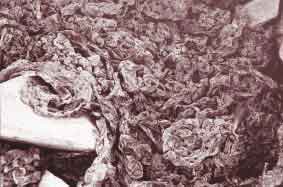| Our Environment: Issue 26 Autumn 2001 |
 The stench from rotting sea lettuce on the shores of the Avon-Heathcote Estuary
got up the noses of many residents over the summer. The Council monitored the problem and
removed the lettuce in parts of the estuary. Sea lettuce is the bright green algae that
grow around the world in sheltered rocky coasts and in estuaries. It grows particularly
well in shallow estuaries where light can penetrate the clear water and water temperatures
are warmer. Nitrogen and phosphorus in coastal rivers or other discharges aid this growth.
Weather patterns that influence the nutrient levels in the oceans also impact on the
growth of sea lettuce in tidal waters.
The stench from rotting sea lettuce on the shores of the Avon-Heathcote Estuary
got up the noses of many residents over the summer. The Council monitored the problem and
removed the lettuce in parts of the estuary. Sea lettuce is the bright green algae that
grow around the world in sheltered rocky coasts and in estuaries. It grows particularly
well in shallow estuaries where light can penetrate the clear water and water temperatures
are warmer. Nitrogen and phosphorus in coastal rivers or other discharges aid this growth.
Weather patterns that influence the nutrient levels in the oceans also impact on the
growth of sea lettuce in tidal waters.
The nuisance caused by the sea lettuce results from the large amounts of plant material that grows over some winter seasons. Given the right conditions it can multiply in the spring and summer period, breaking away and washing up on the shores and shallow areas of the estuary in smelly heaps.
The discharge of treated wastewater from the Christchurch Wastewater Treatment Plant is often said to be the cause of the sea lettuce. While the discharge will be one factor, it is not the major cause of excessive growth. As part of the investigations into wastewater solutions the Council sought scientific advice from NIWA consultants. Their answers indicated that complete removal of the wastewater from the estuary would reduce sea lettuce by up to 50 per cent in some high- growth locations, but overall the reduction would be only about 20 per cent. They also concluded that there would still be the potential for significant growth of sea lettuce with complete removal of the wastewater and large reduction in nutrient loads from the two rivers. The reason for this is that growth is limited as much by the transparency of the water, and by the shearing effect of wind and tidal flows, as it is by the supply of nutrients.
The Christchurch City Council responds to the nuisance caused by sea lettuce by picking up large accumulations in certain areas of the estuary. These areas are restricted to the high tide areas on the eastern side of the estuary. However, when the entire intertidal area is covered in sea lettuce it is not possible to remove it all.
Mike Bourke
Operations and Maintenance Manager
City Water and Waste
| Our Environment Index |